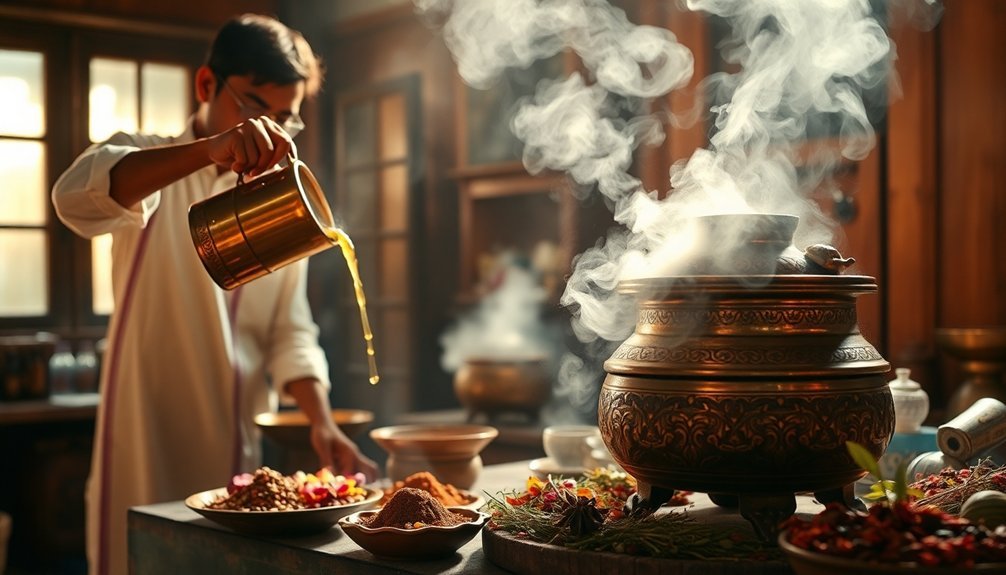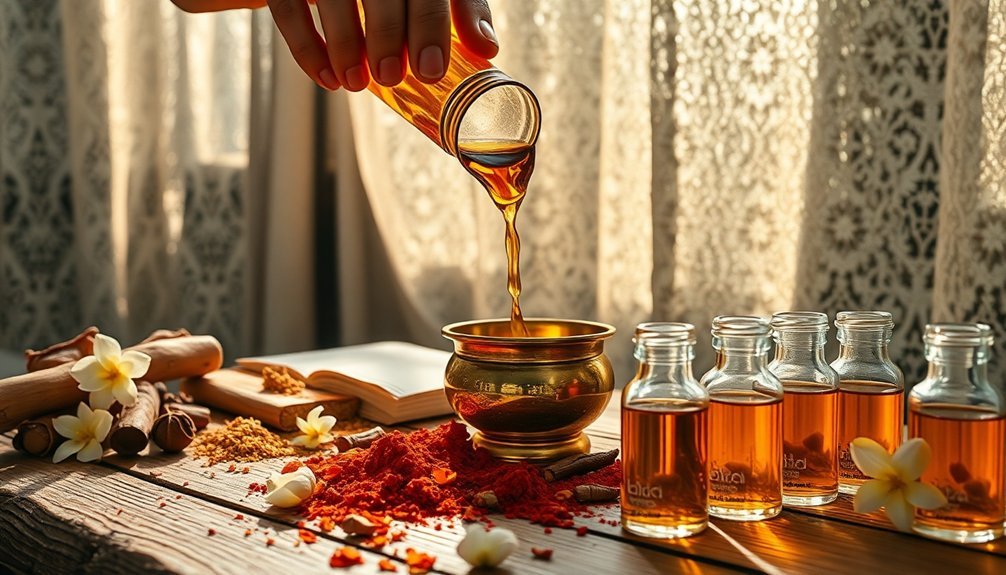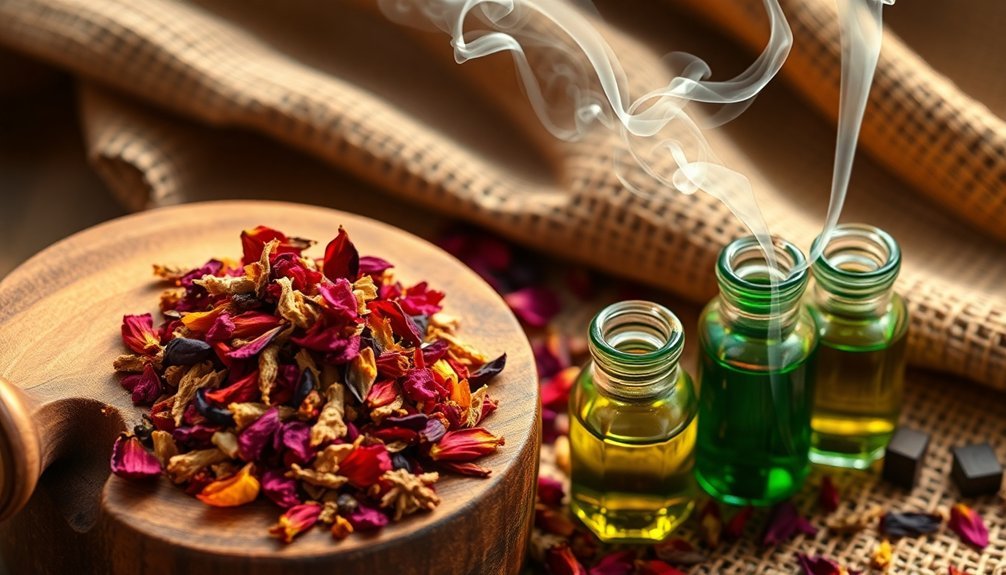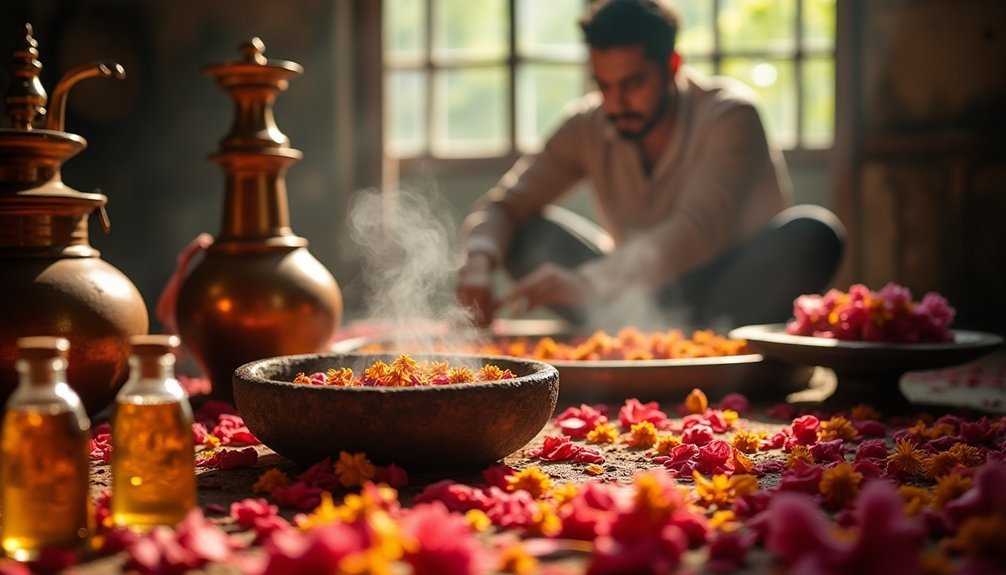India's ancient attar-making encompasses five sophisticated techniques you'll find fascinating. The deg-bhapka method uses copper vessels for aromatic extraction, while effleurage gently steeps delicate flowers in oils. You'll discover sandalwood base infusion taking up to two years, alongside royal maceration techniques perfected in India's courts. The art of natural fixative blending ties these methods together, creating fragrances that have enchanted people for over 5,000 years. This journey into traditional perfumery holds countless more secrets.
The Sacred Deg-Bhapka Distillation Method

Dating back over five millennia, the Deg-Bhapka distillation method represents one of India's most sophisticated aromatic extraction techniques.
You'll find this system's heart in four essential components: the deg, a large copper vessel where plant materials meet water; the bhapka, a narrow-necked receiver that captures fragrant steam; the chonga, a bamboo pipe wrapped in grass rope; and the gachchi, a cooling tank.
When you heat the deg, aromatic vapors rise through the chonga into the bhapka, where they condense in sandalwood oil.
The system's efficiency relies on its clay-ribbon sealing mechanism and the kamani spring that creates a vapor-tight seal.
Due to the current service suspension, many online tutorials demonstrating this ancient technique are temporarily unavailable.
Over 15 days of repeated distillation, you'll witness the sandalwood oil gradually becoming saturated with precious botanical essences.
Ancient Floral Extraction Through Effleurage
While the Deg-Bhapka method harnesses steam's power, India's ancient perfumers developed another remarkable technique for capturing nature's most delicate scents.
The effleurage process, dating back centuries in Indian perfumery, involves gently layering fragile flowers like jasmine and tuberose in high-quality carrier oils or fats.
You'll find this meticulous method requires patience, as the flowers steep for days or weeks in glass or ceramic containers, allowing their subtle fragrances to infuse the oil completely.
The process continues with periodic gentle stirring and multiple layers of fresh flowers to achieve the desired concentration.
This traditional craft, perfected during the Mughal Empire, remains alive in places like Kannauj, where skilled artisans still create these pure, concentrated attars that preserve the flower's most nuanced scents.
This ancient technique originated in the Indus Valley Civilization, where early perfumers first began developing sophisticated fragrance extraction methods.
Traditional Sandalwood Base Infusion Process

At the heart of traditional attar-making lies the intricate sandalwood base infusion process, where master artisans employ the time-tested deg-bhapka system. You'll find copper stills and clay pots working in harmony to extract precious essential oils through steam distillation, a process that can take anywhere from three months to two years. The ancient practice has been a cornerstone of aromatic spiritual rituals for over two millennia.
| Component | Function |
|---|---|
| Sandalwood Oil | Serves as fixative and base note |
| Alpha/Beta Santalol | Creates signature woody aroma |
| Minor Constituents | Adds unique nuanced notes |
The sandalwood's chemical composition, rich in sesquiterpene alcohols, doesn't just provide its characteristic warm, sweet aroma – it's also vital for stabilizing fragile floral notes. You'll discover that this base isn't merely a carrier; it's an essential element that brings depth, longevity, and therapeutic benefits to the final attar composition.
Royal Maceration Technique for Herbs and Spices
Throughout India's royal courts, the art of herb and spice maceration evolved into an elaborate technique that required extraordinary patience and precision.
You'll find that skilled artisans carefully select fragrant materials like vetiver, cardamom, and exotic spices, then soak them in carefully chosen carrier oils. The process can't be rushed – it's a deliberate ritual passed down through generations.
During maceration, you'll notice how artisans maintain strict temperature control to prevent overheating, which could damage the delicate aromatic compounds.
They'll store the macerating mixture in dark, dry spaces, allowing the oils to fully absorb the herbs' essence. The final step involves separating the fragrant oil from any remaining water, creating an attar that's incredibly pure and long-lasting.
This meticulous process can take months or even years to complete.
The Art of Natural Fixative Blending

Since ancient times, the mastery of natural fixatives has formed the foundation of Indian attar creation. You'll find traditional sources like sandalwood oil and agarwood working alongside plant-based fixatives such as rose and jasmine to create lasting fragrances.
These natural elements don't just extend your attar's longevity; they bring depth and stability to each blend.
When you're working with natural fixatives, remember these essential principles:
- Start with a strong base fixative like sandalwood or vetiver
- Layer complementary plant-based fixatives to achieve balance
- Allow proper aging time for the fixatives to blend harmoniously
Through the deg and bhapka system, you'll notice how these fixatives transform during the distillation process, creating a symphony of stable, long-lasting aromas that define authentic Indian attars.
Frequently Asked Questions
How Long Does a Traditional Attar Fragrance Typically Last on the Skin?
You'll find that attar typically lasts 6-12 hours on your skin, but it depends on your skin type, the attar's composition, and how you apply it. Wood-based attars last longer than floral ones.
Which Ancient Indian Attars Were Specifically Reserved for Royal Families?
You'll find that Ood (agarwood oil), Jahangiri Itr (royal rose blend), and attars made from ambergris and musk were exclusively reserved for Mughal royalty. Royal families also claimed special jasmine and sandalwood blends.
Can Traditional Attar Methods Be Adapted for Synthetic Base Materials?
While you can attempt to adapt traditional attar methods, they're not ideal for synthetic materials. You'll face challenges with extraction processes and won't achieve the same complex fragrance profiles that natural ingredients provide.
What Determines the Market Value of Different Types of Attars?
You'll find attar prices are determined by the oud source quality, ingredient purity, brand reputation, packaging quality, and market demand. Higher concentrations and traditional production methods also drive up the value considerably.
How Did Ancient Perfumers Test the Quality of Their Finished Attars?
You'll find ancient perfumers relied on sensory evaluation through smell, visual inspections for clarity, therapeutic property tests, and craftmanship expertise. They'd assess aroma longevity and compare results against established quality standards.
In Summary
You've now explored five timeless Indian attar techniques that have perfumed the subcontinent for centuries. Through these traditional methods – from deg-bhapka distillation to natural fixative blending – you'll understand why attars remain treasured in modern perfumery. Whether you're a fragrance enthusiast or artisan perfumer, these ancient techniques offer invaluable insights into creating authentic, chemical-free perfumes that connect you to India's aromatic heritage.
References
- https://takeonethingoff.com/blog/2021/11/01/the-attar-guide-traditionally-distilled-attars-and-ruhs/
- https://olgaperfume.com/blogs/news/the-rich-heritage-of-indian-perfumes-scents-of-culture
- https://www.birrafragrances.com/blogs/news/attar-making-an-exploration-of-traditional-methods
- https://www.antibrndperfumes.in/blogs/attar-guide/history-of-attar-in-indian-culture
- https://perfumery.co.in/blogs/the-perfumologist/great-indian-ingredients-in-perfumery
- https://ykantiques.com/2015/10/vintage-attar-perfume-distillation-vessel-copper-bhapka/.html
- https://www.outlooktraveller.com/experiences/heritage/petrichor-in-a-bottle
- https://indicanaoud.com/blogs/attar-perfumes/what-is-attar
- https://boondfragrances.com/en-us/pages/the-making-of-boond-fragrances
- https://www.al-raayiha.com/blogs/the-science-behind-attar-extraction





Leave a Reply